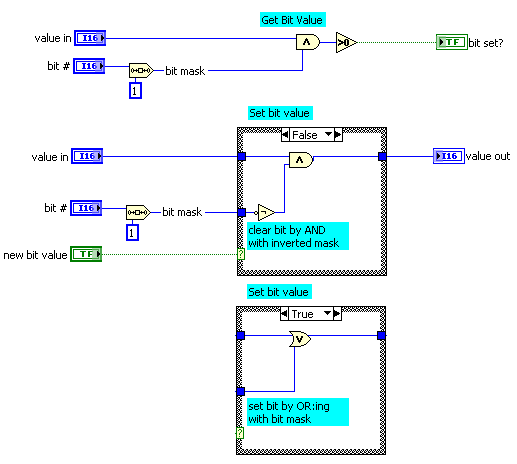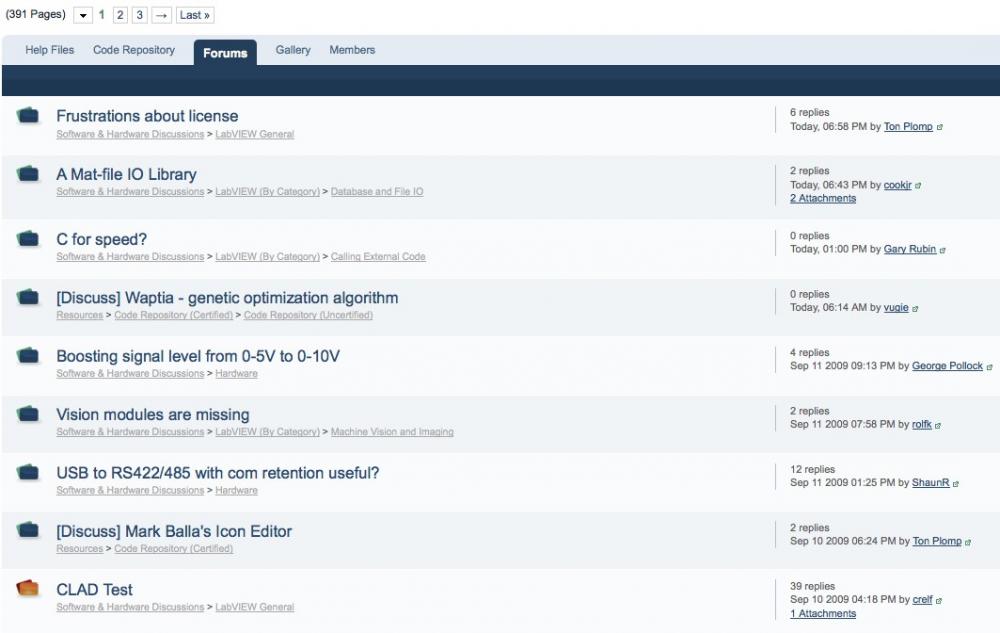
Mellroth
Members-
Posts
602 -
Joined
-
Last visited
-
Days Won
16
Content Type
Profiles
Forums
Downloads
Gallery
Everything posted by Mellroth
-
As I understand it, a preview element always makes a copy of the element data, but a properly used dequeue-enqueue implementation can be made inline. /J
-
Do you really want to create the icon or just display the icon on the front panel? I'm guessing that it is enough to display the icons, so my answers is based on that. There are a number of ways to display pictures in labview, it all depends on how you want the user to see the different items. If you have predefined icons, you can use a picture control to display the pictures. You can also display a set of custom icons in a listbox, multicolumn listbox or tree control (limited to 16 by16 pixels). If you don't need too change the pictures at runtime, you can use the picture ring control to display the different pictures. If it is enough to have static pictures on the FP, you can just copy-paste pictures from Windows directly on the FP /J
-
References Opened in VIs called with "Run VI" method
Mellroth replied to ssv's topic in Application Design & Architecture
Why not just add a Create method (for the reference type you want to create) to the LV2 global, instead of the Add Reference (or whatever it may be called). /J -
Old bugs I pointed out are still there...
Mellroth replied to lecroy's topic in Development Environment (IDE)
Quote of the day I think I'll print that and put it in the Men's room... /J -
You're welcome /J
-
Importing Labview settings from previous version
Mellroth replied to lecroy's topic in Development Environment (IDE)
You can try to copy the labview.ini file from the old version and drop that in the new installation. Some tokens are probably new, but the ones that are the same should use your old settings. /J -
I think the middle picture is wrong, should be using an OR operation instead. Here is another way of doing the bit manipulation Bit manipulation.vi /J
-
No need to correct your grammar (but probably mine ) I just meant that there might be a difference in LV8.5 and 8.6, that prevents the 0 pixel version from working in LV8.6 and higher. /J
-
Can it be that the hack is no longer working in LV 8.6 and higher? (I think the original was made in LV8.5) /J
-
I checked all my backups, but no luck. Let's hope AQ can repost his hack. /J
-
Hi Could you please specify for what type of data you are creating a custom probe, and if possible, include the custom probe itself. Can it be that you are trying to create a custom probe for a LVclass? /J
-
This has been asked for before and thanks to Aristos Queue we have a solution (only on LAVA ). http://lavag.org/top...dpost__p__28056 /J
-
Hmm, fixed you say Seems like a bug, that inserts <B></B> directly after the "exp", even when you add an explicit link. /J
-
I actually think Ton meant not to convert the Express VI, but instead you should configure the express VI by right click, select Properties. This will take you to the DAQ assistant, where you can add/remove channels as you want. I have not checked your code, but if it is already converted to DAQmx code, you will have to restart by adding the DAQ Assistant Express VI from the Express->Input palette. Then configure the channels as needed. /J
-
I'm sorry I haven't answered earlier, but this thread have not showed up in my unread content. Rolf is pretty close in his assumptions; we had DLL's written in C to encode/decode on a windows target, and we implemented a proprietary protocol between the Windows host and the Linux server (running on a PC104) to send/receive the RTP traffic. This way the audio communication was pretty straight forward, much like file I/O, and we could still add any new codecs to our system without having to add new codecs to the Linux server. I did a quick search on ITU-T and come up with the following links for the codecs http://www.itu.int/r...3.1-200605-I/en http://www.itu.int/r...729-200701-I/en http://www.itu.int/r...191-200509-I/en (contains G711 codec as well) /J
-
View Unread Content doesn't display threads I replied in?
Mellroth replied to Yair's topic in Site Feedback & Support
Thanks, I'll probably use this until the "View Unread Content" issues gets sorted out. /J -
View Unread Content doesn't display threads I replied in?
Mellroth replied to Yair's topic in Site Feedback & Support
I still get the same behaviour, e.g. I noticed new posts in this thread on the Forum start page, but when I checked Unread content the thread does not show up (see attached image). A while back I actually switched to the other setting, because it seemed to catch more of the new post, but it is still not 100%. Now I'm back with the setting proposed. /J -
I really like to be able to have both byRef and byValue within the same class.That way I can have a number of high speed access members, and still beable to use ByRef on data that need it. So please don't force peopleinto selecting one type or the other. /J
-
View Unread Content doesn't display threads I replied in?
Mellroth replied to Yair's topic in Site Feedback & Support
Same here. I sometimes miss the LAVA 1.0 behavior, where my last post showed up at unread content, sort of a confirmation of my post. /J -
Hi, You can catch the mouse-down event on the Tree control, and discard this event if a disabled element (row + column) was clicked. /J
-
It was my understanding that the changes made to the compiler shouldn't have made things worse, but allow for more future optimizations. Obviously I was wrong The good part, however, is that the DVR outperforms the SEQ. It is therefore possible to tweak all instances where SEQs are used. All Producer-Consumer patterns, using queues, will still be 30% slower. Do you know of any other slowdown in LabVIEW 2009 to be aware of? /J
-
Hi, If you really want to go for the ini-file format, I recommend that you check the OpenG Variant Configuration File VIs. These VIs let you read/write clusters directly to an ini-file. Apart from the header, what kind of data are you dealing with? /J
-
I'm just starting to play with LV2009, and tested the DVR against a Single Element Queue (SEQ). Compared to a SEQ in LabVIEW 8.6.1 the DVR runs about 2 times faster, but if I compare the SEQ speed in LV 2009 against SEQ speed in LV 8.6.1 the speed has decreased. The access time in LV 2009 goes up ~30%. After seeing this I also measured the time it takes to add 100 000 elements (I32 values) to a queue and then remove them. In LV8.6.1 this takes ~80ms, in LV2009 it takes ~105ms, which is pretty close to 30% increase in access time. Have anyone else seen this, or any other decrease in performance? /J
-
Hi, I'm not sure if you just want to create a proprietary VOIP application in LabVIEW, or if you want to create a h323 VOIP application? Building a proprietary VOIP protocol could be done just as crelf suggested. Back in 2001 we developed an IP phone test equipment, and at that time we didn't have access to LabVIEW-RT, so we went with a Linux implementation to handle the RTP communication (we also needed very low level access to the network interfaces). The codecs (g711, g723, g729ab) were downloaded from ITU-T, and just compiled for our target. Today you can probably handle the RTP streams directly in LabVIEW-RT, but I would still use codecs downloaded from ITU-T, and not spend time developing my own set of codecs in LabVIEW. /J
-
Hi aleks, I would go for the second solution. If you are streaming a lot of data and want that to be deterministic, you might also want to consider to write data to disk in chunks where the size is an multiple of the block size used by the hard drive. The reason is that LabVIEW RT does not cache data, so if you are not writing complete blocks, it first has to read data to be able to write to a block on disk. /J



